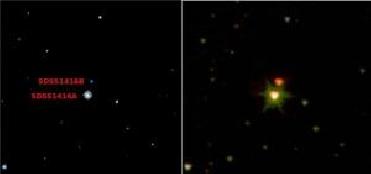
UKIRT UKIDSS near-infrared image of SDSS1416+13AB (left panel) and the Spitzer+UKIDSS image at mid-infrared wavelengths (right panel). UKIRT/Spitzer photo
NEW DELHI (BNS): Astronomers have discovered the “coolest” sub-stellar body ever found outside the solar system.
The discovery of SDSS1416+13B, have excited astronomers at the University of Hertfordshire who found the object using the United Kingdom Infrared Telescope (UKIRT) in Hawaii.
The SDSS1416+13B, was found in a wide orbit around a somewhat brighter and warmer brown dwarf, SDSS1416+13A. The pair is located between 15 and 50 light years from the solar system, which is quite close in astronomical terms, according to a Science Daily report.
"This looks like being the fourth time in three years that the UKIRT has made a record breaking discovery of the coolest known brown dwarf, with an estimated temperature not far above 200 degrees Celsius," said Dr Philip Lucas.
"We have to be a bit careful about this one because its colours are so different than anything seen before that we don't really understand it yet…” he said.
Dr Ben Burningham first noticed SDSS1416+13B during a dedicated search for cool brown dwarfs in the UKIRT Infrared Deep Sky Survey (UKIDSS).
A near infrared spectrum taken with the Japanese Subaru Telescope in Hawaii showed that it is a type of brown dwarf called a T dwarf, which has a lot of methane in its atmosphere, but with peculiar features including a big gap at certain wavelengths.
He noticed also that a previously observed brighter star (SDSS1416+13A) which appears close by in the UKIDSS discovery image was also a brown dwarf.
After further investigations of the SDSS1416+13B at longer wavelengths using the orbiting Spitzer Space Telescope, it was found to be the reddest known brown dwarf at these wavelengths by some margin. Comparison with theoretical models of the brown dwarf atmospheres then provided a temperature estimate of about 500 Kelvin (227 degrees Celsius).
Too small to be stars, brown dwarfs have masses smaller than stars but larger than gas giant planets like Jupiter. Due to their low temperature these objects are very faint in visible light, and are detected by their glow at infrared wavelengths.
They were originally dubbed "brown dwarfs" long before any were actually discovered, to describe the idea of bodies that were cooler, fainter and redder than red dwarf stars, with the colour brown representing the mix of red and black.
 Previous Article
Previous Article Next Article
Next Article













The Indian Air Force, in its flight trials evaluation report submitted before the Defence Ministry l..
view articleAn insight into the Medium Multi-Role Combat Aircraft competition...
view articleSky enthusiasts can now spot the International Space Station (ISS) commanded by Indian-American astr..
view article